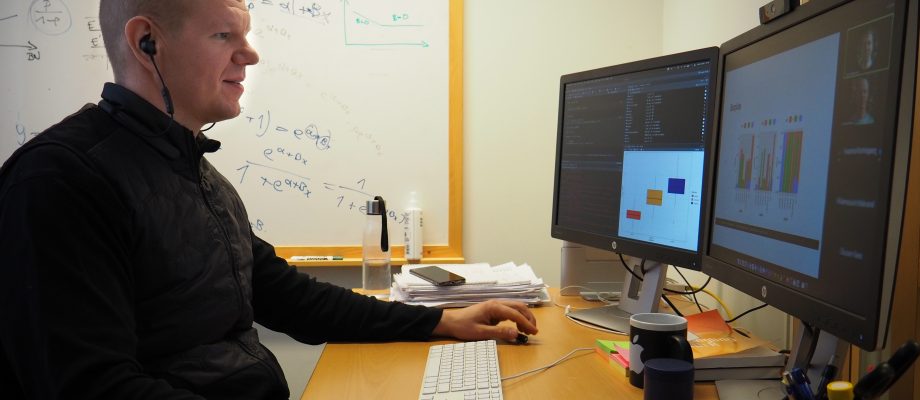EDUCATION. As the only paper on teaching, Sanna Abrahamson’s and Marcela Davila’s paper was selected to be part of the proceedings in an online special issue of Bioinformatics in July 2021. The study, which is based on student evaluations of online courses during the pandemic, suggests a combination of four elements to improve the online learning experience.
The four elements that the study suggests to be combined are: short synchronized sessions that are teacher led, extended time for own and group practical work, recorded live lectures, and increased opportunities for students to receive feedback on their acquired skills.
“We wanted to take advantage of the crisis to improve our online teaching”, says Sanna Abrahamsson, referring to the COVID-19 pandemic. “We have always evaluated our classroom-based courses, but the difference now was that we had to improve each course immediately by listening to what our students asked for, and by using each course to improve our methods in the coming one.”
65 students from five courses

Sanna, who works as bioinformatician at Core Facilities, used the evaluations not only to improve the courses, but also as data for her study on online learning designs. 65 out of 75 students responded to the evaluations from a total of five PhD courses in Bioinformatics.
The courses are short and practical, with one-hour lecture or demonstration followed by practical work during the rest of the day. All five courses are designed as onsite training, but due to the pandemic, the courses shifted to online teaching with students spread out, each on their own.
“Bioinformatics in itself is computer based, so where students and teachers actually sit is not a big issue. Adapting the onsite design to online design is the big challenge, and we realized quickly that using the onsite design would not be adequate for online teaching.”
Adapting to the online format
During their first online course, Sanna and the teaching team kept their onsite time plan: first one hour lecture and the rest of the day (6 hours) practical work assisted by the teacher. This turned out to be difficult as both motivation and focus was hard for students to maintain, while sitting each in front of their own screen. The practical sessions was therefore shortened to a maximum of two hours, and instead, self-studies where given double the amount of time. This gave students greater autonomy while also demanding more of their own planning skills.
“We also noticed that we needed to keep the interaction between students and teachers on a high level, so we developed new methods to do so and to identify parts of the class that students found to be extra difficult. Usually, when you meet face-to-face, those moments is easier to point out.”
Boosting Confidence
“We also increased the opportunities where students could try out their newly acquired skills together with fellow students, or through feedback from the teacher. We noticed that this boosted
their confidence about the concepts learned, and we could identify which areas in the course we needed to focus more on.”
At first, students where often hesitant to have their cameras switched on, but with time they got used to the idea.
“Today almost all cameras are on, and I have a feeling that most students are comfortable with speaking out. The atmosphere is quite similar to an onsite course.”
Applied on other areas
The methods that are highlighted in the study can be applied on other areas, not only Bioinformatics, as long as the course does not demand that students are present on campus full time. The course design suits short online courses in particular, says Sanna.
”The reaction we have received from those who read the paper is that the results and the suggested course design is relevant for their own teaching, since many universities have struggled with similar issues regardless of the courses’ subject”, Sanna says and adds:
“Our study also gives us a chance to look into the pros and cons of both online and onsite teaching of the same course, since we have evaluations from both settings.”
In the first online course, some of the lectures where recorded ahead of class and posted with transcribed presentation notes. The evaluation, on the other hand, showed that the students preferred a live streamed lecture where they could interact with the teacher, as well as possibility to look back at a recording.
TEXT & PHOTO: CHARBEL SADER
About the Journal and the Conference
The leading journal in its field, Bioinformatics publishes the highest quality scientific papers and review articles of interest to academic and industrial researchers.
For the on special issue, 289 papers where submitted. The submitted papers where thoroughly reviewed with each paper receiving at least 3 reviews. 55 were accepted for presentation at the ISMB/ECCB conference, and where also published.
Sanna Abrahamsson’s and Marcela Davila’s study was the only paper on education that was selected as part of the proceedings. Marcela also participated in the ISMB/ECCB conference as moderator of a seminar in the technology track.
ISMB/ECCB is the leading international forum for presenting new research results, disseminating methods and techniques and facilitating discussions among leading researchers, practitioners and students in the field. In addition, ISMB is the flagship conference of the International Society for Computational Biology (ISCB). Due to the worldwide COVID-19 pandemic, the ISMB/ECCB 2021 meeting, initially intended to be held in Lyon, France, was for the second time run as a fully virtual conference.











